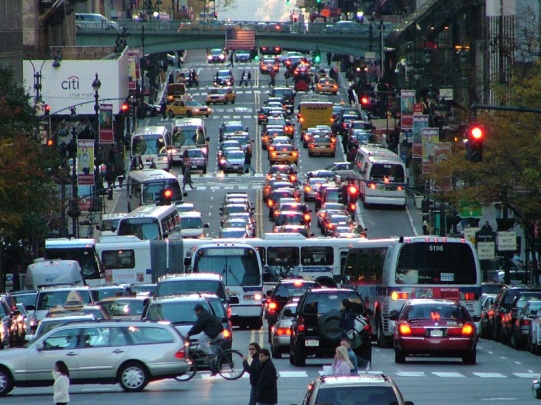I’m once again looking for an unusual digital story that differs significantly from the others that I’ve looked at in this blog. Expanding my concept of digital storytelling, I found a digital story called Traffic Patterns about how humans make a very special type of wave pattern in traffic. It’s part of the Engines of Our Ingenuity series on the Educational Uses of Digital Storytelling web site from the University of Houston.

Having lived many years in large cities such as Denver, I’m very familiar with the ebb and flow of traffic. Even though I now live in a small town with very little traffic congestion, I can still feel the tension and anger I used to experience when I would sit at a traffic light where it would take numerous cycles before I made it through the light, only to go through the same thing again at the next light. Not realizing it, I was part of a kinematic wave.
Kinematic waves in traffic are created by our minds. Knowing that it’s dangerous to get too close to a car in front of us, we create a “safe” distance between us and the next car. 35 mph seems to be the speed that allows for the greatest speed and safety combination. But due to many possible interruptions (accidents, traffic lights, etc.), the cars get closer and closer. And when the jam starts to clear, a wave is formed that travels in only one direction – backwards as we drive away from it. So even though they look like a physical phenomenon, they’re actually a social contract. Part of our instinct to live harmoniously together. And they’re as reproducible as physical waves such as sound or water waves.

So next time you’re sitting in that traffic jam feeling anger and frustration, take a moment to remember that you’re part of a social phenomenon known as a kinematic wave.
I enjoyed this story because the topic is unusual and interesting. It’s a short video made up of only still images and the narrator’s voice. But it’s put together so nicely that there is a real sense of being at a location due to the sequencing of the images.
Ohler’s assessment traits –
- Story: The story in this digital story is different from many of the other stories that I have examined. There is an emotional content, but it is more complex than in the usual digital story. The emotion comes from the idea that this kinematic wave is part of an experience that is very frustrating to many people. So there is not a lot of drama to the story, but there is a tapping into that common emotional experience that so many people know. For someone who has lived their entire lives in a small town without traffic problems, this story probably has much less significance to them. So the emotion comes from a common and relatable experience, which is a technique that we can use in our own stories to make them more powerful.
- Economy: This story is a very short story (only 3:26) that explains a very complex idea. The use of images to tell the story actually makes it more economical because the image can be shown for only a second to get across an idea, or longer if needed. Video imagery might make this story longer due to using longer sequences to tell the story (such as video of traffic driving to get the idea across vs a quick image of cars driving). So using images is a good technique for keeping our stories economical.
- Media application: I thought the use of the narrators voice and the series of images was very effective at telling the story. With the right sequence of images it is possible to give a sense of movement (or lack thereof) to the story. I also liked how they used older black and white images to introduce the topic, which gives us a sense of being in the forties or fifties, and then they switched to color images as they started talking about the waves in current times.

Hi David,
I went to school and worked in Los Angeles, so like you, I had a bit of anxiety when the film started out with all those long lines of cars. I’m glad in Colorado Springs I don’t have to deal with that now. As the film went on, I began to feel encouraged that all those endless hours sitting in traffic wasn’t a waste of time after all, and that I had actually been part of a huge, ongoing science experiment on kinematic waves :). (I guess road rage could be considered an anomaly in the social science aspect.) This is an interesting way to look at traffic. I used to be mesmerized by the colorful light patters I would see as a child on city newscasts and now I know why—they’re a patterned wave! That is very cool. I wonder, though, when we all start riding around in Tesla self-driving cars how the wave will change, since our moment-by-moment decision-making will be taken out of the equation. Maybe it will be the “autonomous kinematic wave.” Hmmm, now you got me thinking. Thanks for the read!
LikeLike